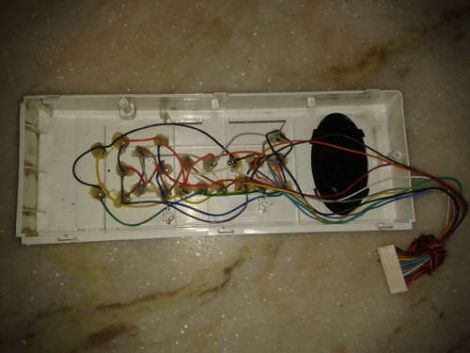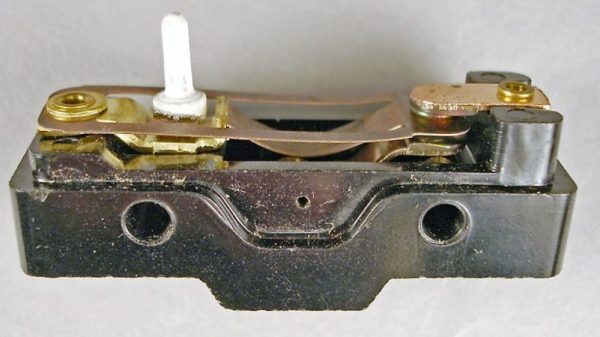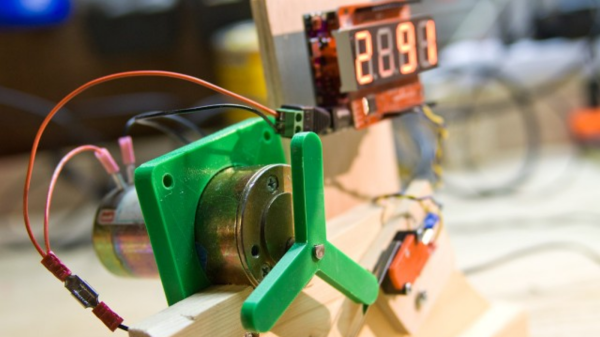You find them everywhere from 3D printers to jet airliners. They’re the little switches that detect paper jams in your printer, or the big armored switches that sense when the elevator car is on the right floor. They’re microswitches, or more properly miniature snap-action switches, and they’re so common you may never have wondered what’s going on inside them. But the story behind how these switches were invented and the principle of physics at work in the guts of these tiny and useful switches are both pretty interesting.
microswitch12 Articles
Endurance Test Machine Is Not Quite Useless
It seems [Pete Prodoehl] was working on a project that involved counting baseballs as they fell out of a chute, with the counting part being sensed by a long lever microswitch. Now we all know there are a number of different ways in which one can do this using all kinds of fancy sensors. But for [Pete], we guess the microswitch was what floated his boat — likely because it was cheap, easily available and replaceable, and reliable. Well, the reliable part he wasn’t very sure about, so he built a (not quite) Useless Machine that would conduct an endurance test on the specific switch brand and type he was using. But mostly, it seemed like an excuse to do some CAD design, 3D printing, wood work and other hacker stuff.
The switches he’s testing appear to be cheap knock-off’s of a well known brand. Running them through the torture test on his Useless Machine, he found that the lever got deformed after a while, and would stop missing the actuator arms of his endurance tester completely. In some other samples, he found that the switches would die, electrically, after just a few thousand operations. The test results appear to have justified building the Useless Machine. In any case, even when using original switches, quite often it does help to perform tests to verify their suitability to your specific application.
Ideally, these microswitches ought to have been compliant to the IEC 61058 series of standards. When switches encounter real world loads running off utility supply, their electrical endurance is de-rated depending on many factors. The standard defines many different kinds electro-mechanical test parameters such as the speed of actuation, the number of operations per minute and on-off timing. Actual operating conditions are simulated using various types of electrical loads such as purely resistive, filament lamp loads (non-linear resistance), capacitive loads or inductive loads. There’s also a test involving a locked rotor condition. Under some of the most severe kinds of electrical loads, a switch may be expected to last just a few hundred operations. But if the switch is used for low power applications (contact current below 20 mA), then it is expected to last up to its mechanical endurance limit. For most microswitches, this is usually in the range to 100,000 to 300,000 operations.
Coming back to his project, his first version was cobbled together as a quick hack. A 3D-printed lever was attached to a motor fixed on a 3D-printed mount. The switch was wired to an Arduino input, and a four-digit display showed the number of counts. On his next attempt, he replaced the single lever with a set of three, and in yet another version, he changed the lever design by adding small ball bearings at the end of the actuator arms so they rolled smoothly over the microswitch lever. The final version isn’t anywhere close to a machine that would be used to test these kind of switches in a Compliance Test Laboratory, but for his purpose, we guess it meets the bar.
For those interested, here is a great resource on everything you need to know about Switch Basics. And check out the Useless Machine in action in the video below.
Continue reading “Endurance Test Machine Is Not Quite Useless”
Scratch-built Radial Solenoid Engine Is Polished And Professional
There’s something alluring about radial engines. The Wasps, the Cyclones, the Gnomes – the mechanical beauty of those classic aircraft engines can’t be denied. And even when a radial engine is powered by solenoids rather than internal combustion, it can still be a thing of beauty.
The solenoid engine proves that he has some mechanical chops. If you follow along in the videos below, you’ll see how [Tyler] progressed in his design and incorporated what he learned from the earliest breadboard stage to the nearly-complete engine. There’s an impressive amount of work here – looks like the octagonal housing was bent on a press brake, and the apparently homebrew solenoids are enclosed in copper pipe and fittings that [Tyler] took the time to bring to a fine polish. We’re skeptical that the microswitches that electrically commutate the engine will hold up to as many cycles are they’d need to handle for this to be a useful engine, but that’s hardly the point here. This one is all about the learning, and we think [Tyler] has done a bang-up job with that.
For more radial solenoid engine goodness, check out this engine with an entirely different take on commutation. Or if you need the basics of radial engine theory, this wood mockup might be just the thing.
Continue reading “Scratch-built Radial Solenoid Engine Is Polished And Professional”
Microswitch Keyboard Gives Those Lazy Thumbs A Workout

Upon first sight there will be no doubt in anyone’s mind that this is a hacker’s keyboard. [Tim Tyler] built the odd-looking conglomeration of keys a few years ago with the goal of improving the man-machine interface. Why waste all that thumb space with just one long keyboard when you can have at least nine keys per thumb?
After some additional consideration this isn’t all that unorthodox. We’ve seen keyboards that split the hands; in fact you can buy them. This just adds the thumb matrices and that rack of programmable keys above the alpha-numeric portion. It’s rather organ-like with its multiple ranks, don’t you think? Check out the demonstration video after the break. It certainly has a keystroke sound that is all its own. The sound is different from the clackity “M” keyboard and its modern relatives thanks to the microswitches that make up each key.
Continue reading “Microswitch Keyboard Gives Those Lazy Thumbs A Workout”
Repaired Microwave Keypad Looks As Good As New

Instructables user [Rohit] had an out-of-warranty microwave with a broken membrane keypad. Much like our friend [Alexandre] from Brazil, he found the cost of replacement parts beyond reasonable, so he had to find a way to repair it instead.
He disassembled the front cover of his microwave to get at the main controller board. Once it was detached, he removed the keypad’s cover to get a closer look at the matrix underneath. While taking notes on how the matrix was wired, he found that some keypad traces connected to other traces rather than buttons. He says that they are likely used by the microwave to detect that the keypad is present, so he made sure to short those traces out on the controller board when he wired everything back together.
He replaced the aging keypad with microswitches, but rather than mount them on the front panel of the microwave, he drilled holes for each switch so that he could mount them inside the face plate. Once everything was wired and glued in place, he re-mounted the keypad’s cover. Now the microwave looks stock but has firm, reliable, user-serviceable buttons that are sure to last quite a while.













